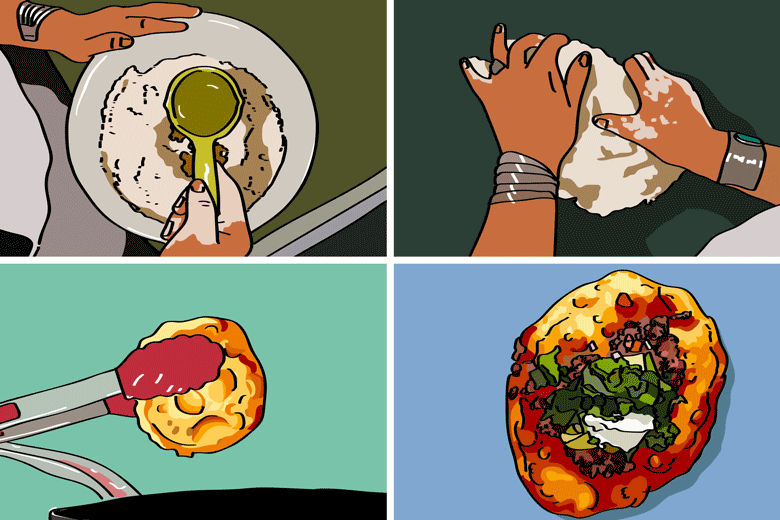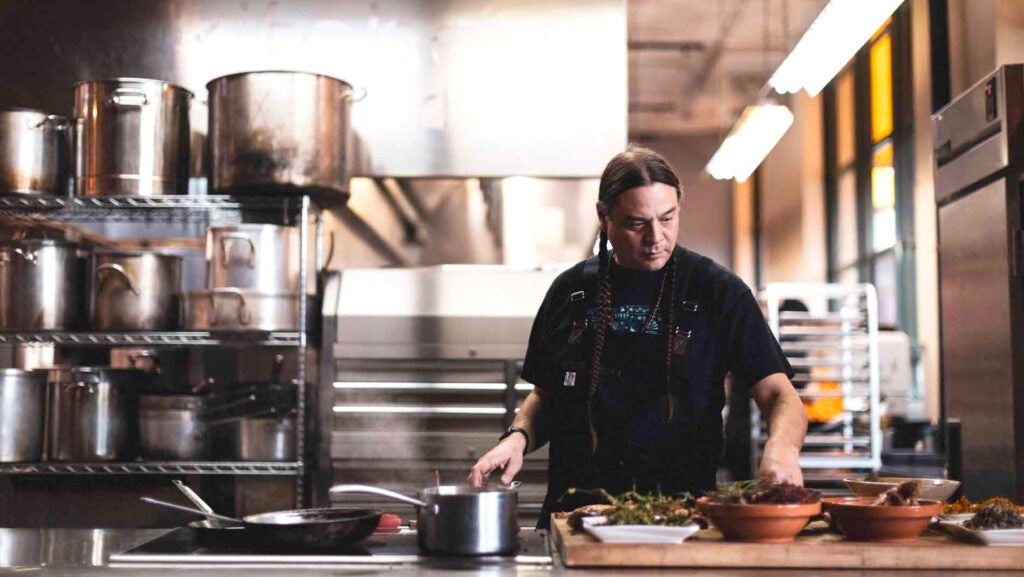
Chef Sean Sherman honors his heritage while creating a new type of Native American cuisine.
As I travel the world with my work revitalizing Indigenous food sovereignty, a typical conversation with a stranger often goes like this:
Person: “So, what do you do?”
Me: “Well, I’m a chef. I have a restaurant in Minneapolis called Owamni.”
Person: “Oh! What kind of food?”
Me: “Native American.”
Person: “Oh, I love frybread!”
I don’t always tell the person that I don’t actually serve frybread in our restaurant.
When I was first starting out with our food truck, Tatanka Truck, in Minneapolis in 2015, I was a bit worried about how people would react when they found out that I wouldn’t be serving frybread. But it’s worked out pretty well.
The philosophy I developed early on was to highlight modern Indigenous foods while removing colonial ingredients that were introduced to the Americas, including beef, pork, chicken, dairy, white flour, and cane sugar.
This approach automatically eliminates frybread, which is a flat dough bread, usually made with wheat flour and deep-fried in oil or lard. Frybread still remains one of the most recognizable Native American foods, even though it has nothing to do with the Indigenous diet prior to the arrival of Europeans.
Frybread makes people really happy. When I was a kid growing up on Pine Ridge Reservation in South Dakota, we loved frybread because it was always around on special occasions, and whenever we’d go to powwows, there would always be frybread. It was typically served with a side of chokecherry or blueberry wojape (a berry sauce), with a soup or stew, or sometimes sprinkled with powdered sugar for a sweet treat.
But the history of frybread is a complicated one filled with painful facts, and as I continue in my life’s work to re-Indigenize American foodways, these conversations about frybread can also be complicated.
Tracing the history of frybread begins around 1864, when the US military was forcing Native peoples onto reservations, showing them how to utilize the flour rations they were given after stripping away their access to heritage foods like wild plants and game. These rations included big bags of white flour and lard. Frybread slowly became a staple, because it has carbs for energy and it tastes good, but it’s a subsistence food, and eating a lot of it doesn’t help our community’s disproportionate rates of heart disease, obesity, and type 2 diabetes.

Sean Sherman
My friend the chef Ben Jacobs, a member of the Osage nation, has done an amazing job of showcasing Indigenous foods and producers at his Denver restaurant Tocabe. While frybread is served alongside some of their signature dishes, like Red Lake Nation wild rice and cured and braised bison ribs, Ben is acutely aware of our complicated relationship with frybread. He is uncomfortable with being thought of as a frybread expert, but he also sees the strong cultural role that frybread plays and the joy it brings to our modern Indigenous communities.
“While we have the oldest cultures on the planet, we have the youngest cuisine because we are dealing with an eradicated food system,” he says. “So I think it’s very cool that we are currently recreating what our food can become. We are all very different tribally, but frybread is one thing that ties us all together, and you can’t take that from us.”
Ben thinks it’s disrespectful to the women who kept their communities alive with frybread to say that frybread is now killing us. That narrative takes away from the ingenuity of our communities that had no choice. And while the evolution of Native cuisine is really powerful, he says, that doesn’t mean we should run away from the history of frybread—however painful it may be—as we go forward.
“As the women in our communities were forced into a place and basically imprisoned, they utilized historical knowledge and techniques [to prepare] a bunch of ingredients they knew nothing about, and they created survival using that knowledge,” he says. “Frybread may have been forced on us, but our people were highly intelligent and knowledgeable and practical, and they said ‘We will not die. We will survive.’”
Ben and I are male chefs who own restaurants, but the true legacy of the dish really belongs to women, and specifically to home cooks who are women.
My friend Charlene Hollow Horn Bear, Itazipco Lakota, is known in her community of Red Lodge, Montana, for her frybread. “If you make frybread and send out the word, people just start showing up,” she says. “If I say, ‘Hey, I have a buffalo roast in the oven,’ no one shows up for that!”
Like most people, Charlene has fond early memories of frybread, especially those related to spending time with the women who made it. “They’d be sitting in this little spot, frying the bread and telling me, ‘Whenever you make food for people, you have to do it with positive energy and good thoughts so that it will go into the food, because you’re feeding the spirits of people,” she says. “‘Think of something that makes you happy,’ they would say. And if you’re in a negative way, think of something that makes you smile, and then do your bread that way.’”
She also remembers being so poor on her reservation, Cheyenne River in South Dakota, that her household staple food was a watery vegetable soup—if you needed more, you added more water. “I remember the old ones, they’d be breaking open beef bones with mallets to put bone marrow in the soup,” she explains.
Frybread still remains one of the most recognizable Native American foods, even though it has nothing to do with the Indigenous diet prior to the arrival of Europeans.
In Charlene’s household, they ate gabubu bread, a variation on frybread made with less oil and cooked in a skillet instead of deep-fried. And it was a truly welcome addition to the soup if they had it.
Justin Pioche is a Ashihii Diné chef who grew up in New Mexico, where frybread was first introduced to Natives. In his New Mexico–based catering business, Pioche Food Group, Justin does serve frybread, but he says he always offers corn tortillas as an alternative, because they are healthier and, in his opinion, more delicious.
“We got forced off of our land on the Long Walk [the ethnic cleansing by forced march of the Diné, or Navajo, people at the hands of the US government],” Justin explains. “We were forced to use these ingredients that we weren’t familiar with, like flour and lard. And that sucks, because it’s such a [tasty] food, but it’s really bad for you.”
He recalls early stories about rations where people would mix the flour with water and drink it—raw flour being unsafe to consume—causing some people to die. Like Ben, Justin is proud of the ingenuity and resiliency of his people as they learned to use what was available to them. “It’s a cool story, but it’s also a sad story.”
During Justin’s multicourse dinners, he uses frybread as a storytelling tool to spread knowledge about this history that far too few people seem to be aware of.
“People say that they want ‘traditional Navajo food’ and then go on to say that they want Navajo tacos (which are made with frybread). That’s not traditional Navajo food,” he says. “If you want to go traditional, then I’m gonna have to bring game, berries, grains, wild vegetables, and stuff like that. That’s true Native American food.”
I’ve spent my career trying to revitalize what is true Native American food. My menus are full of wild game and birds, fish, plants, corn, beans, bison, even insects. I don’t think people are going to give up frybread altogether anytime soon—nor should they have to. However, it’s time to stop waiting for Europeans to “discover” us to make our food known—and frybread is a part of that painful Eurocentric legacy.
We need to paint the picture and the story differently, and to start uplifting our own, true cultural foods.
And eat our frybread too.
Photo: Bill Phelps